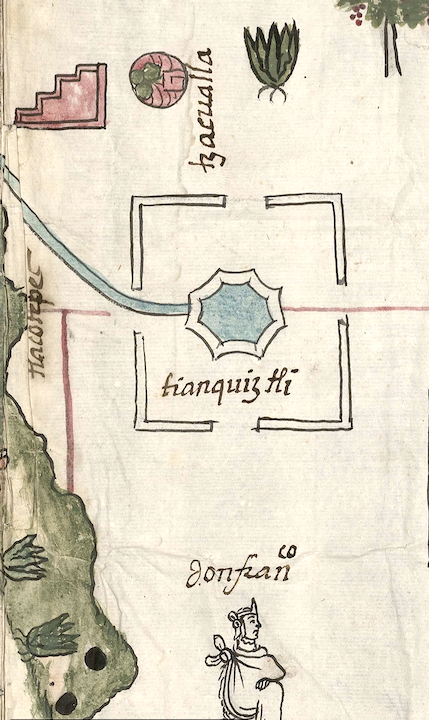tianquiztli (CmpRG)
This simplex glyph stands for tianquiztli, or “marketplace.” It appears on the 1580 Relación Geográfica de Cempoala (Zempoala, Hidalgo). Betraying a marked cultural evolution in representation, it is more “Spanish” than Nahua. We are relying on the Nahuatl gloss (tianquiztli, see below) to identify the feature for what it is. The marketplace is shown in a bird's eye view as a square or courtyard surrounded on four sides by black-outlined walls. There are four openings leading into the marketplace, which has a scalloped-edged element in its middle that appears to be a fountain. It has a black-edged wall and is shaded aqua blue in its center.
Autonomous-era glyphs for a market had round shapes with sometimes elaborate designs inside the circles, such as small concentric circles (like beads or water droplets) and multiple footprints suggesting a bustling commercial activity.
In Nahua culture, the word tianquiztli was also applied to a constellation, which may have been owing to some coincidence of shape between the standard marketplace and the arrangement of the stars (citlalli) that made up the constellation.
Robert Haskett
Though heavily European in its form, this element seems to be standing in for the more traditional tianquiztli glyph that is made up of concentric circles, some of them typically containing decorations such as groups of short parallel lines or small circles, and a center that can be blank, be filled with dots, or even human footprints. Note some of these more traditional forms, below, as well as a more transitional one that has a cross planted in its middle. In the present case, the marketplace water feature is being fed by a conduit of water, outlined in black and shaded in the same blue found in the feature itself. This conduit eventually connects it to an elevated, arched aqueduct depicted on one corner of the manuscript. This aqueduct still exists and is a noted feature in the landscape even today (see the Museum and Rare Books comparison, below). For a brief discussion of the marketplace see Ballesteros García (2005), 83-84.
Robert Haskett
tianquiztli
tianquiztli
Robert Haskett
1580
Robert Haskett
marketplaces, mercados, Cempohuallan
This is a photo of the Acueducto del Padre Tembleque, a structure built between the the 1550s and '70s. It is located to the east of Zempoala, and is on Unesco World Heritage List (https://en.wikipedia.org/wiki/Aqueduct_of_Padre_Tembleque).
tianquiz(tli), market, place of commerce, https://nahuatl.wired-humanities.org/content/tianquiztli
el mercado
Robert Haskett
Relación de Cempoala - University of Texas Libraries Collections. 1580-11-01. https://collections.lib.utexas.edu/catalog/utblac:f87917e2-e3c9-4eb2-a83...
Materials that are in the public domain (such as most of the maps in the PCL Map Collection) are not copyrighted, and no permission is needed to copy them. You may download them and use them as you wish. The image appears here courtesy of the University of Texas Libraries, The University of Texas at Austin. If you do publish anything from this database, please cite the Visual Lexicon of Aztec Hieroglyphs.






